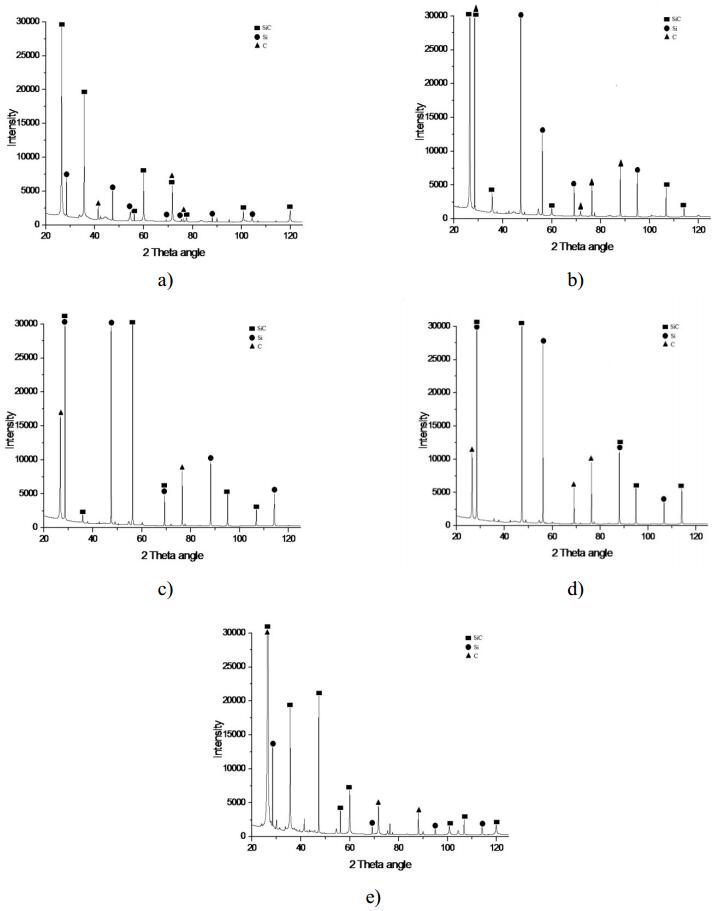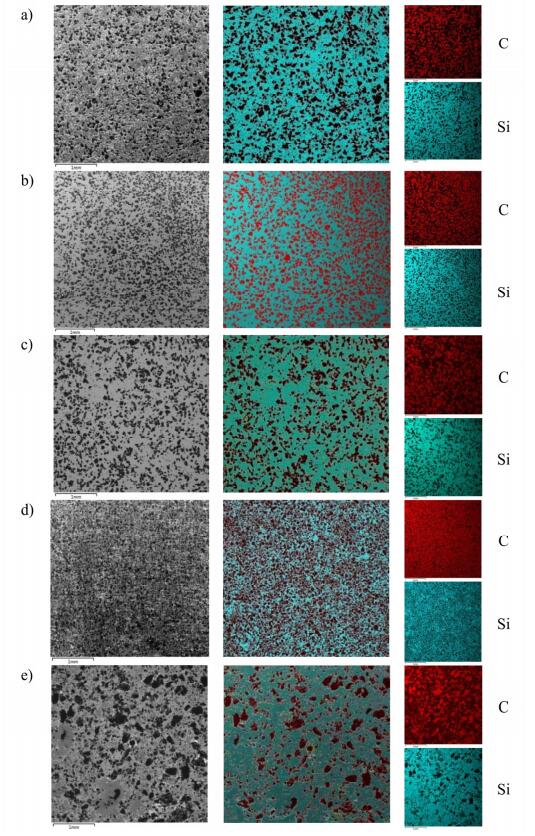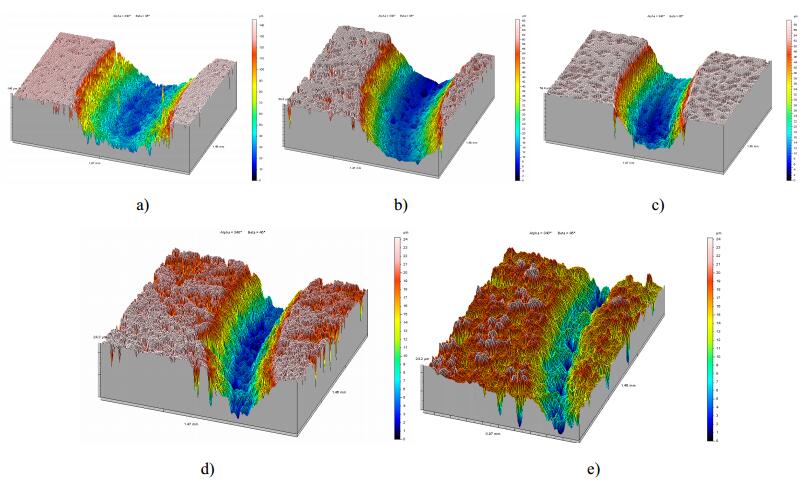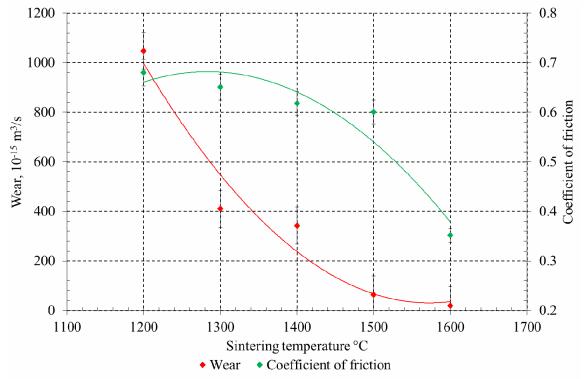Friction coefficients and wear resistance are determined, and the x-ray phase composition of experimental samples of obtained material on the basis of silicon and carbon is studied in this paper. Secondary products of the industry were used as initial powder to conduct spark plasma sintering. The composition of burden used for sintering, which was 75% of the mass of silicon and 25% of the mass of graphite (carbon basis), was determined by calculation. Studied samples were obtained by spark plasma sintering method.
Based on the analysis of results of the phase composition of the samples obtained by spark plasma sintering method using secondary products of the industry as the initial components, the following conclusions can be made:
- It was found that all samples obtained by the method of spark plasma sintering consist of the following phases: The phase of metallic silicon (cubic crystal lattice), the phase of graphite (hexagonal crystal lattice), the phase of silicon carbide with cubic and hexagonal lattice and have a low coefficient of friction;
- It was determined that the mass fraction of the silicon carbide phase content is from 20 to 30% depending on the heating temperature;
- It was found that the increase in the sintering temperature of the samples have a beneficial effect on the wear intensity of obtained ceramic material;
- It was found that from the obtained samples of carbide silicon ceramics the wear resistance of the material increases and the friction coefficient and wear decrease due to an increase in the mass fraction of the carbide phase, that is, a more dense frame is formed.
Based on the above, we can say that with an increase in the sintering temperature, the interaction of powder components forms a more stable frame of silicon carbide, which is proved by conducted phase analysis.
1.
Introduction
The branch IAE RSE NNC RK is currently working on obtaining a new material for Kazakhstan, based on silicon carbide, using industrial scrap as the initial components.
As it is known, nowadays the concept of industry transformation of the Republic of Kazakhstan involves the creation of technologies for obtaining fundamentally new materials that ensure the development aside from scientific field, also individual sectors of the economy. Such materials include powder metallurgy products, in particular, silicon carbide ceramics. Silicon carbide materials have high temperature resistance, corrosion resistance, thermal resistance, high tribological and mechanical characteristics due to its structural features. New materials created by powder metallurgy methods are in some cases the basis for radical improvement of existing and creation of new technological processes in engineering, metallurgy, oil, chemical, nuclear and other industries.
Material based on silicon carbide is one of the widely used and demanded ceramic materials. However, there is no production of this material in Kazakhstan. Silicon carbide has chemical stability, high resistance to high temperatures and radiation exposure. It is used as mechanical end seals, disc brakes and a component of composite armor. In addition, it is used as a layer of threestructural-isotropic coating for nuclear fuel elements in high-temperature power reactors and etc. [1,2,3].
It is known that standard technologies of silicon carbide manufacturing consist in quantitative synthesis of carbides by reaction of hydrocarbons in the plasma with dispersed oxide raw material [4]. The method for silicon carbide production by heating a mixture of silicon dioxide and a carbon-containing substance in a plasma flow is also known [5]. In the above manufacturing technologies of this material, finished products from recycled natural raw materials are used as components of the product. Studied samples were obtained by the method of spark plasma sintering using secondary industrial products such as graphite and quartz scraps and others as initial components.
The purpose of this paper is to determine the tribological characteristics and study the phase composition of the samples obtained by the method of spark plasma sintering using secondary products of industry as the initial components.
2.
Materials and methods
Experimental samples were obtained for the study by the method of spark plasma sintering (SPS), the sintering parameters are presented in Table 1.
SPS-technology involves the transmission of direct current in the "on-off switching" mode. There are electrical discharges during the current flow in the contact points of the particles, leading to a local temperature increase. At that, material is melted, diffusion processes are sharply accelerated. At the next stage of current transmission, high-temperature areas occur on the other points of the sample. Thus, the process ensures uniform sintering of the material in the entire volume of the workpiece. During sintering in the contact areas of the powder particles, the destruction of oxide films occurs, which contributes to a more efficient compaction of the powder mixture. The use of impulse current can reduce sintering time to a few minutes. Experts note that the high efficiency of the SPS method is due to the balance between the processes of compaction (sintering) of the material and the growth of particles as a result of recrystallization of the material [6,7,8,9,10].
The method allows to control effectively the porosity of sintered materials and to obtain compact samples of compounds, the usual pressing of which is practically impossible. Spark plasma sintering is one of the possible ways to reduce energy consumption in the production of materials. During the process of SPS it is not required to conduct a preliminary treatment of the material with pressure and there is no need to use special binders. Manufacturing of parts is occurred immediately in the final form. The initial microstructure of the powders is preserved. In addition, with the use of analyzed method, it is possible to obtain materials of a completely new type with low thermal stability.
To obtain high-density compacts, we can use lower holding times for SPS compared to conventional sintering time. Reduction of holding time contributes to the reduction of microstructural evolutions as a result of diffusion control of phase transformations [10].
The phase composition was determined using Empyrean X-ray diffractometer with automatic registration and processing of the measurement results by Panalytical Company. Radiation: Cu Kα; voltage and current: 45 kV, 40 mA. Dimension of scanning pitch −0.013°2θ. Exposure time: 70.15 s. The size of fixed slit of divergence of 1° (the distance from divergence slit to the focus tube 87 mm), non-scattering slit of 2°, the mask of the incident beam with the marking 15, which provides the width of the incident beam of 14.9 mm. The investigated area of the 2θ angles ranged from 20° to 125° was used. The temperature of the air during the shooting is 18 ℃. Shooting was performed with the rotation of the holder at a speed of 0.5 rev/s.
The structure and element composition of the material were studied in a VEGA-3 LMH scanning electron microscope equipped by an X-Act energy-dispersive detector.
Mechanical tests to determine the coefficient of friction was conducted on ТНТ-S-АХ0000 tribometer of CSEM production (Switzerland). Load to the indicator was 100 N. The rotational speed 1450 rev/min.
The determination of wear resistance was determined on Micro Measure 3D Station three-dimensional non-contact profilometer.
3.
Results and discussion
Figure 1a shows diffractogram of SiC-1 sample. The phase of graphite (hexagonal crystal lattice), the phase of metallic silicon (cubic crystal lattice) and peaks of low intensity, which are well corresponded with the main lines of polytype silicon carbide silicon carbide 96R with a hexagonal crystal lattice, space group R 3 m or silicon carbide with a cubic lattice space group F-43 m (216) were detected on the surface of the sample.
In the subsurface layer of the sample the phase composition is represented by the same 3 main phases (graphite, silicon carbide metal). Quantitative evaluation gives approximately equal weight content of them.
Figures 1b and 1c show diffractograms of SiC-2 and SiC-3 samples respectively. The following phases are determined most accurately: the phase of metallic silicon (cubic crystal lattice), the phase of graphite (hexagonal crystal lattice), and the low-intensity peaks that find a well match with the basic lines of silicon carbide with cubic crystal lattice, the spatial group F-43 m (216) and a similar silicon carbide called muasannit 3C.
Figure 1d shows diffractogram of SiC-4 sample. The crystal modification of hexagonal graphite, metallic silicon and silicon carbide is confidently identified as the main phases in the phase composition of the sample.
Peaks corresponding to the lines of hexagonal graphite are characterized by a large half-width, which can correspond to the small size of the crystallites, a small degree of perfection of the crystal lattice and other reasons, indicating a small degree of graphitation of the graphite in the sample. General overestimation of the lines intensity of graphite chart, which is clearly seen in Figure 1, reveals that the intensities of the peaks of the experimental diffractogram do not correspond to the intensities of the lines of the reference phase, which may indicate the presence of the predominant orientation of the crystallites (texture) of graphite in the sample and other structural differences from the reference phase. Peaks identified for the correspondence of the cubic lattice of metallic silicon and the crystal lattice of the cubic modification of silicon carbide, on the contrary, are characterized by a small half-width have well resolution of Kα1, 2 characteristic radiation doublet (Figure 1), and a well general agreement of peaks intensity of the experimental diffractogram with the intensities of the reference phase lines. Crystal modification of silicon carbide of cubic crystal system is selected from a number of candidate reference phases including hexagonal and rhombic modifications on the basis of the best conformity assessment.
Figure 1e shows the diffraction pattern of SiC-5 sample. Crystalline phases of hexagonal graphite and metallic silicon are confidently identified as the main phases in the phase composition of the sample. Crystal modification of silicon carbide of cubic crystal system was selected from the list of candidate phases based on the analysis experience of the phase composition of sample 4.
The result of qualitative analysis and semi-quantitative assessment of the phase content according to diffractograms shows that the mass fraction of the phase content of silicon carbide is from 20 to 30% depending on the heating temperature, which is an indicator that the interaction of silicon and carbon at temperatures occurred properly.
Figure 2 shows results of sample microstructure research containing 70 wt% silicon and 25 wt% graphite after spark plasma sintering at 1200, 1300, 1400, 1500 and 1600 ℃. Microstructure analysis showed that all samples are three-phase structure. Dark spots, which more look like pores, are carbon phase that is more evident on surface mapping of samples. When overlapping colors we see formation of silicone carbide phase. It should be noted that carbide phase predominates on the surface, which is more likely due to sintering temperature that causes silicon melting and displaces it on the surface.
Determination of friction coefficients were obtained on the tribometer, wear rate was 115 rev/min at a load of 10 N, the frequency is 2 Hz, at room temperature of 25 ℃, the diameter of the used ball was 3 mm, the material was tungsten carbide. Table 2 shows the friction coefficient of the samples and the wear rate. Characteristics and the depth of wear are shown in Figure 3. Determination of the friction coefficient shows that at higher temperatures, the coefficient data is decreased. Also it is noteworthy that wear intensity decreases with increasing of sintering temperature.
As can be seen from Figure 3, the surfaces of the samples of carbide-silicon ceramics have a slight roughness, which does not affect the nature and depth of wear of the samples. In [11], nanostructured silicon carbide samples used in the aviation industry have a friction coefficient similar to the results in this work. However, the process of preparation and production of nanostructured silicon carbide is more laborious, in contrast to the production of silicon carbide described in this paper.
Figure 4 shows that with an increase in the sintering temperature of the samples, the friction coefficient decreases. If, at a sintering temperature of 1200 ℃, the coefficient of friction is 0.68, then with an increase in the sintering temperature to 1600 ℃, it decreases to 0.252. It should be noted that the wear of the material decreases from 1048 m3/s at a sintering temperature of 1200 ℃ to 20.26 × 10−15 m3/s.
Obtained results confirm available data on low friction factor and wear. This is due to the fact that firmer silicon carbide matrix is generated as sintering temperature increases, which has a positive effect on properties of resulting material.
4.
Conclusion
Based on the analysis of results of the phase composition of the samples obtained by spark plasma sintering method using secondary products of the industry as the initial components, the following conclusions can be made:
- It was found that all samples obtained by the method of spark plasma sintering consist of the following phases: The phase of metallic silicon (cubic crystal lattice), the phase of graphite (hexagonal crystal lattice), the phase of silicon carbide with cubic and hexagonal lattice and have a low coefficient of friction;
- It was determined that the mass fraction of the silicon carbide phase content is from 20 to 30% depending on the heating temperature;
- It was found that the increase in the sintering temperature of the samples have a beneficial effect on the wear intensity of obtained ceramic material;
- It was found that from the obtained samples of carbide silicon ceramics the wear resistance of the material increases and the friction coefficient and wear decrease due to an increase in the mass fraction of the carbide phase, that is, a more dense frame is formed.
Based on the above, we can say that with an increase in the sintering temperature, the interaction of powder components forms a more stable frame of silicon carbide, which is proved by conducted phase analysis.
Acknowledgment
The research was supported by the Committee of Science of the Ministry of Education and Science of the Republic of Kazakhstan for 2018 "Properties and Characteristics of the Core Material Melt of Nuclear Reactor Produced in IGR Research Reactor" (Contract No. 305 dated 30.03.2018).
Conflict of interests
The authors declare that there is no conflict of interests regarding the publication of this paper.









 DownLoad:
DownLoad:







